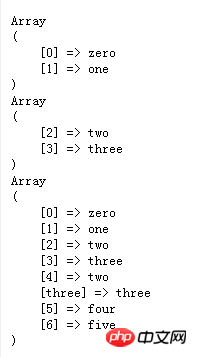
L'exemple de cet article décrit l'implémentation PHP de fonctions simples d'intersection, de différence et d'union pour les tableaux. Partagez-le avec tout le monde pour votre référence, les détails sont les suivants :
<?php $arr1 = array( '0' => 'zero', '1' => 'one', '2' => 'two', '3' => 'three' ); $arr2 = array( '2' => 'two', 'three' => 'three', '4' => 'four', '5' => 'five' ); //差集【对比返回在 arr1 中但是不在 arr2 及任何其它参数数组中的值。】 $array_diff = array_diff($arr1,$arr2); echo "<pre class="brush:php;toolbar:false">"; print_r($array_diff); /* 输出结果 *Array *( * [0] => zero * [1] => one *) */ //交集【对比返回既在 arr1 中也在 arr2 数组中的值。】 # 注意事项: 键值保留arr1数组中的键值不变 $array_intersect = array_intersect($arr1,$arr2); echo "<pre class="brush:php;toolbar:false">"; print_r($array_intersect); /* 输出结果 *Array *( * [2] => two * [3] => three *) */ //并集【将arr1数组中的值附加在arr2数组的后面。返回作为结果的数组。 】 #注意事项:【如果输入的数组中有相同的字符串键名,则该键名后面的值将覆盖前一个值。 #然而,如果数组包含数字键名,后面的值将不会覆盖原来的值,而是附加到后面。】 $array_merge = array_merge($arr1,$arr2); echo "<pre class="brush:php;toolbar:false">"; print_r($array_merge); /* 输出结果 * Array * ( * [0] => zero * [1] => one * [2] => two * [3] => three * [4] => two * [three] => three * [5] => four * [6] => five * ) */ ?>
Résultats en cours d'exécution :

Ce qui précède est le contenu détaillé de. pour plus d'informations, suivez d'autres articles connexes sur le site Web de PHP en chinois!
 Comment ouvrir le fichier php
Comment ouvrir le fichier php
 Comment supprimer les premiers éléments d'un tableau en php
Comment supprimer les premiers éléments d'un tableau en php
 Que faire si la désérialisation php échoue
Que faire si la désérialisation php échoue
 Comment connecter PHP à la base de données mssql
Comment connecter PHP à la base de données mssql
 Comment connecter PHP à la base de données mssql
Comment connecter PHP à la base de données mssql
 Comment télécharger du HTML
Comment télécharger du HTML
 Comment résoudre les caractères tronqués en PHP
Comment résoudre les caractères tronqués en PHP
 Comment ouvrir des fichiers php sur un téléphone mobile
Comment ouvrir des fichiers php sur un téléphone mobile